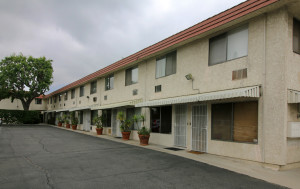California Real Estate Words Definition
[All words in boldface type are explained in this Glossary.]
abandon/abandonment – the tenant’s remedy of moving out of a rental unit that is uninhabitable and that the landlord has not repaired within a reasonable time after receiving notice of the defects from the tenant.
amount of notice/amount of advance notice -the number of days’ notice that must be given before a change in the tenancy can take effect. Usually, the amount of advance notice is the same as the number of days between rent payments. For example, in a month-to-month tenancy, the landlord usually must give the tenant 30 days’ advance written notice that the landlord is increasing the amount of the security deposit.
appeal – a request to a higher court to review a lower court’s decision in a lawsuit.
Application for Waiver of Court Fees and Costs – a form that tenants may complete and give to the Clerk of Court to request permission to file court documents without paying the court filing fee.
arbitration – using a neutral third person to resolve a dispute instead of going to court. Unless the parties have agreed otherwise, the parties must follow the arbitrator’s decision.
arbitrator – a neutral third person, agreed to by the parties to a dispute, who hears and decides a dispute. An arbitrator is not a judge, but the parties normally must follow the arbitrator’s decision (the decision is said to be “binding” on the parties). (See arbitration; compare to mediator.)
assign/assignment – an agreement between the original tenant and a new tenant by which the new tenant takes over the lease of a rental unit and becomes responsible to the landlord for everything that the original tenant was responsible for. The original tenant is still responsible to the landlord if the new tenant doesn’t live up to the lease obligations. (See novation; compare to sublease.)
California Department of Fair Employment and Housing – the state agency that investigates complaints of unlawful discrimination in housing and employment.
Claim of Right to Possession – a form that the occupants of a rental unit can fill out to temporarily stop their eviction by the sheriff after the landlord has won an unlawful detainer (eviction) lawsuit. The occupants can use this form only if: the landlord did not serve a Prejudgment Claim of Right to Possession form with the summons and complaint; the occupants were not named in the writ of possession; and the occupants have lived in the rental unit since before the unlawful detainer lawsuit was filed.
credit report – a report prepared by a credit reporting agency that describes a person’s credit history for the last seven years (except for bankruptcies, which are reported for 10 years). A credit report shows, for example, whether the person pays his or her bills on time, has delinquent or charged-off accounts, has been sued, and is subject to court judgments.
credit reporting agency – a business that keeps records of people’s credit histories, and that reports credit history information to prospective creditors (including landlords). (See also tenant screening service.)
credit score – a numerical summary of a person’s credit worthiness that is based on information from a credit reporting agency. Credit scoring uses a statistical program to compare a person’s history of bill paying, credit accounts, collection actions and other credit information with the credit performance of other consumers. A high credit score (for example, 750 and up) indicates that a person is a better credit risk, and a low score (for example, 300 – 400) indicates a potential credit risk.
default judgment – a judgment issued by the court, without a hearing, after the tenant has failed to file a response to the landlord’s complaint.
Demurrer – a legal response that a tenant can file in an unlawful detainer lawsuit to test the legal sufficiency of the charges made in the landlord’s complaint.
Discovery – the process through which parties to an action are allowed to obtain relevant information known to other parties or non-parties before trial
discrimination (in renting) – denying a person housing, telling a person that housing is not available (when the housing is actually available at that time), providing housing under inferior terms, harassing a person in connection with housing accommodations, or providing segregated housing because of a person’s race, color, religion, sex (including pregnancy, childbirth or medical conditions related to them, as well as gender and perception of gender), sexual orientation, national origin, ancestry, source of income, age, disability, medical condition, whether the person is married, or whether there are children under the age of 18 in the person’s household. Discrimination also can be refusal to make reasonable accommodation for a person with a disability.
dishonored check – a check that the bank returns to the payee (the person who received the check) without paying it. The bank may return the check because the payor’s (the check writer’s) account did not have enough money to cover the check. This is called a “bounced” or “NSF” check. Or, the bank may return the check because the payor stopped payment on it.
escrow account – a bank account into which a tenant deposits withheld rent, to be withdrawn only when the landlord has corrected uninhabitable conditions in the rental unit or when the tenant is ordered by a court to pay withheld rent to the landlord.
eviction – a court-administered proceeding for removing a tenant from a rental unit because the tenant has violated the rental agreement or lease, or did not comply with a notice ending the tenancy (also called an “unlawful detainer ” lawsuit).
eviction notice (or three-day notice) – a three-day notice that the landlord serves on the tenant when the tenant has violated the lease or rental agreement. The three-day notice usually instructs the tenant to either leave the rental unit or comply with the lease or rental agreement (for example, by paying past-due rent) within the three-day period.
fair housing organizations – city or county organizations that help renters resolve housing discrimination problems.
federal stay (or automatic stay) – an order of a federal bankruptcy court that temporarily stops proceedings in a state court, including an eviction proceeding.
guest – a person who does not have the rights of a tenant, such as a person who stays in a transient hotel for fewer than seven days.
habitable – a rental unit that is fit for human beings to live in. A rental unit that substantially complies with building and safety code standards that materially affect tenants’ health and safety is said to be “habitable.” See uninhabitable and implied warranty of habitability.
holding deposit – a deposit that a tenant gives to a landlord to hold a rental unit until the tenant pays the first month’s rent and the security deposit.
implied warranty of habitability – a legal rule that requires landlords to maintain their rental units in a condition fit for human beings to live in. A rental unit must substantially comply with building and housing code standards that materially affect tenants’ health and safety. The basic minimum requirements for a rental unit to be habitable are available in the Dealing With Problems section.
initial inspection – an inspection by the landlord before the tenancy ends to identify defective conditions that justify deductions from the security deposit.
item of information – information in a credit report that causes a creditor to deny credit or take other adverse action against an applicant (such as refusing to rent a rental unit to the applicant).
landlord – a business or person who owns a rental unit, and who rents or leases the rental unit to another person, called a tenant.
lease – a rental agreement, usually in writing, that establishes all the terms of the agreement and that lasts for a predetermined length of time (for example, six months or one year). Compare to periodic rental agreement.
legal aid organizations – organizations that provide free legal advice, representation, and other legal services in noncriminal cases to economically disadvantaged persons.
lock out – when a landlord locks a tenant out of the rental unit with the intent of terminating the tenancy. Lockouts, and all other self-help eviction remedies, are illegal.
lodger – a person who lives in a room in a house where the owner lives. The owner can enter all areas occupied by the lodger, and has overall control of the house.
mediation – a process in which a neutral third person meets with the parties to a dispute in order to assist them in formulating a voluntary solution to the dispute.
mediator – a neutral third person, agreed to by the parties to a dispute, who meets with the parties in order to assist them in formulating a voluntary solution to the dispute. The mediator’s decision normally is not “binding” on the parties.(See mediation; compare to arbitrator.)
Memorandum to Set Case for Trial – a court document filed in an unlawful detainer lawsuit requesting that the case be set for trial. This document also states whether the plaintiff (the landlord) has requested a jury trial.
Motion to Quash Service of Summons – a legal response that a tenant can file in an unlawful detainer lawsuit if the tenant believes that the landlord did not properly serve the summons and complaint.
negligence – a person’s carelessness (that is, failure to use ordinary or reasonable care) that results in injury to another person or damage to another person’s property.
novation – in an assignment situation, a novation is an agreement by the landlord, the original tenant, and the new tenant that makes the new tenant (rather than the original tenant) solely responsible to the landlord.
occupant – a person who is not named as a tenant in the rental agreement or lease who has moved into a rental unit before the landlord files an unlawful detainer (eviction) lawsuit. Since the landlord does not know that the occupant is living in the rental unit, the landlord may not name the occupant as a defendant in the unlawful detainer lawsuit.
periodic rental agreement – an oral or written rental agreement that states the length of time between rent payments – for example, a week or a month – but not the total number of weeks or months that the agreement will be in effect.
Prejudgment Claim of Right to Possession – a form that a landlord in an unlawful detainer (eviction) lawsuit can have served along with the summons and complaint on all persons living in the rental unit who might claim to be tenants, but whose names the landlord does not know. Occupants who are not named in the unlawful detainer complaint, but who claim a right to possess the rental unit, can fill out and file this form to become parties to the unlawful detainer action.
prepaid rental listing services – businesses that sell lists of available rental units.
relief from forfeiture – an order by a court in an unlawful detainer (eviction) lawsuit that allows the losing tenant to remain in the rental unit, based on the tenant’s convincing the court that the eviction would cause the tenant severe hardship and that the tenant can pay all of the rent that is due, or otherwise fully comply with the lease.
rent control ordinances – laws in some communities that limit or prohibit rent increases, or that limit the circumstances in which a tenant can be evicted.
rent withholding – the tenant’s remedy of not paying some or all of the rent if the landlord does not fix defects that make the rental unit uninhabitable within a reasonable time after the landlord receives notice of the defects from the tenant.
rental agreement – an oral or written agreement between a tenant and a landlord, made before the tenant moves in, which establishes the terms of the tenancy, such as the amount of the rent and when it is due. (See lease and periodic rental agreement.)
rental application form – a form that a landlord may ask a tenant to fill out prior to renting that requests information about the tenant, such as the tenant’s address, telephone number, employment history, credit references, and the like.
rental period – the length of time between rent payments; for example, a week or a month.
rental unit – an apartment, house, duplex, or condominium that a landlord rents to a tenant to live in.
renter’s insurance – insurance protecting the tenant against property losses, such as losses from theft or fire. This insurance usually also protects the tenant against liability (legal responsibility) for claims or lawsuits filed by the landlord or by others alleging that the tenant negligently injured another person or property.
repair and deduct remedy – the tenant’s remedy of deducting from future rent the amount necessary to repair defects covered by the implied warranty of habitability. The amount deducted cannot be more than one month’s rent.
retaliatory eviction or action – an act by a landlord, such as raising a tenant’s rent, seeking to evict a tenant, or otherwise punishing a tenant because the tenant has used the repair and deduct remedy or the rent withholding remedy, or has asserted other tenant rights.
security deposit– a deposit or a fee that the landlord requires the tenant to pay at the beginning of the tenancy. The landlord can use the security deposit, for example, if the tenant moves out owing rent or leaves the unit damaged or less clean than when the tenant moved in.
serve/service – legal requirements and procedures that seek to assure that the person to whom a legal notice is directed actually receives it.
60 day notice – a written notice from a landlord to a tenant telling the tenant that a periodic tenancy will end in 60 days. A 60-day notice usually does not have to state the landlord’s reason for ending the tenancy.
sublease – a separate rental agreement between the original tenant and a new tenant to whom the original tenant rents all or part of the rental unit. The new tenant is called a “subtenant.” The agreement between the original tenant and the landlord remains in force, and the original tenant continues to be responsible for paying the rent to the landlord and for other tenant obligations. (Compare to assignment.)
subpoena – an order from the court that requires the recipient to appear as a witness or provide evidence in a court proceeding.
subtenant – see sublease.
tenancy – the tenant’s exclusive right, created by a rental agreement between the landlord and the tenant, to use and possess the landlord’s rental unit.
tenant – a person who rents or leases a rental unit from a landlord. The tenant obtains the right to the exclusive use and possession of the rental unit during the lease or rental period.
tenant screening service – a credit reporting agency that collects and sells information on tenants, such as whether they paid their rent on time, whether they damaged previous rental units, whether they were the subject of an unlawful detainer lawsuit, and whether landlords considered them good or bad tenants.
three-day notice – see eviction notice.
30-day notice – a written notice from a landlord to a tenant telling the tenant that the tenancy will end in 30 days. A 30-day notice usually does not have to state the landlord’s reason for ending the tenancy.
uninhabitable – a rental unit which has such serious problems or defects that the tenant’s health or safety is affected. A rental unit may be uninhabitable if it is not fit for human beings to live in, if it fails to substantially comply with building and safety code standards that materially affect tenants’ health and safety, if it contains a lead hazard, or if it is a dangerous substandard building. (Compare to habitable.)
unlawful detainer lawsuit – a lawsuit that a landlord must file and win before he or she can evict a tenant (also called an “eviction” lawsuit).
U.S. Department of Housing and Urban Development – the federal agency that enforces the federal fair housing law, which prohibits discrimination based on sex, race, color, religion, national or ethnic origin, familial status, or handicap.
waive – to sign a written document (a waiver) giving up a right, claim, privilege, etc. In order for a waiver to be effective, the person giving the waiver must do so knowingly, and must know the right, claim, privilege, etc. that he or she is giving up.
writ of possession – a document issued by the court after the landlord wins an unlawful detainer (eviction) lawsuit. The writ of possession is served on the tenant by the sheriff. The writ informs the tenant that the tenant must leave the rental unit by the end of five days, or the sheriff will forcibly remove the tenant.






